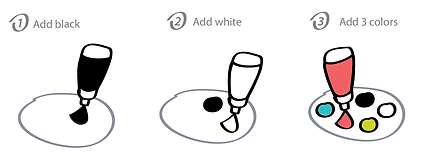EXPRESS YOURSELF - Portrait Painting
MODULE: Painting | GRADE LEVELS: 1 - 6 | DURATION: 1 Hour
PROJECT 24 | 04.25.22
ARTIST VIDEO
Video Editing by Jorge Davies, Graphics by Melissa Sabol
PROJECT VIDEO
OVERVIEW
A self-portrait can communicate a great deal about your emotional state. For this project you will paint a portrait of your face (from the neck up) using paint, a brush, and cardboard. Your choice of colors, shapes, lines and brushstrokes will give clues to the viewer about how you are feeling at this moment.
WHY IT'S IMPORTANT
-
Offers an emotional outlet
-
Learn basic techniques to create facial features - eyes, nose, mouth,
-
See how slight change in a line or position of a shape
-
Use shapes, lines, colors, and brushstrokes to communicate information
-
Create a portrait that is more about how you feel than how you look
-
Emphasizes depicting inner feelings over replicating reality
-
Learn to create in the moment without planning
MATERIALS
-
Cardboard Sheet (8 x 11)
-
Acrylic Paint (black, white & 3 colors)
-
Paint brushes (1 large & 1 small)
-
Paper Plate
-
Jar of Water
-
Paper Towel
INSTRUCTIONS
1. PREPARE PAINT
-
Squeeze a blob of black paint onto paper plate “palette”.
-
Add a blob of white paint, being sure to leave space between colors.
-
Add three more colors of paint along the outside edge of the plate.

2. PAINT BACKGROUND
-
Using a large brush, paint the background using one or more colors to reflect how you feel.
-
Cover the entire area with paint. Try not to overmix the colors or it will turn a grey-brown. Use a little water to help spread the paint.
-
Allow a few minutes for the paint to dry.

3. OUTLINE FACE & ADD FEATURES
-
Using your small brush and black paint, to paint an oval that takes up most of the cardboard.
-
Select one or more of the examples to create facial features.








ARTISTS TO KNOW
_1981_JPG.jpg)
Jean Michel Basquiat
Was a graffiti artist and a neo-expressionist painter. He earned a certain amount of fame from his graffiti art in New York in the 1970’s. He collaborated with artist Andy Warhol. Many books, collections of poems and films have been inspired by his work and his life.
Untitled, 1981, painting

Alexei von Jawlensky
Was a Russian expressionist painter who lived in Germany. He studied art at several art academies. He is known for his style of painting. His directional brush strokes, mystical subjects and his rich use of color. His works can still be seen in museums around the world.
Portrait of a Woman with Green Fan, 1912, painting

Pablo Picasso - paintings of Dora Maar
Was a Spanish painter, sculpture, printmaker and ceramicist. He lived most of his life in France. He is most famous for his many paintings. He painted in many different styles. Dora Maar was one of his expressionistic paintings. It sold at auction in 2006 for $95.2 million dollars.
Portrait of Dora Marr , 1937, painting
VOCABULARY
Background: the part of a painted or carved surface against which represented objects and forms are perceived or depicted; a portrait against a purple background.
Brushstroke: the marks made with a paintbrush, when applying paint to a canvas.
Emotion: any of the feelings of joy, sorrow, fear, hate, love, etc.
Expression: indication of feeling, spirit, character, etc., as on face, in the voice, or in artistic execution.
Facial Features: eyes, ears, nose, mouth, or any of the other distinctive qualities of a face like freckles, dimples, or beauty marks.
Gesture: a movement or position of the hand, arm, body, head, or face that is expressive of an idea, opinion or emotion.
Outline: the line by which a figure or object is defined or bound.
Portrait: a likeness of a person, especially of the face, as in a painting, drawing, or photograph.
Self Portrait: a likeness of a person, especially of the face, as in a painting, drawing, or photograph, created by the subject of the portrait.